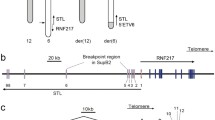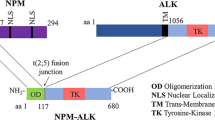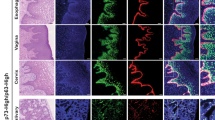Abstract
The DiGeorge critical region 6 (DGCR6) gene exists in two highly homologous copies (DGCR6 and DGCR6L) on chromosome 22q11 and is deleted in patients with velo-cardio-facial syndrome/DiGeorge syndrome (VCFS/DGS). The DGCR6 mRNA levels are increased in metastatic mammary tumour cells and regulate the expression of neighbouring genes at the 22q11 region. Newly developed monoclonal antibodies detected predominantly nuclear phosphoproteins of approximately 25 kDa, with low expression levels in the cytoplasm. Both proteins have half-lives of about 2.5 h. Exogenously expressed DGCR6 and DGCR6L migrated with slightly different mobility in SDS-gels in accordance with two immunoreactive bands observed for the endogenous proteins. DGCR6 is found at low levels in primary human fibroblasts or peripheral blood mononuclear cells, while tumour cells, B-cells transformed by EBV as well as activated normal human T cells, contain elevated levels of the proteins. The proteins are differentially expressed in mammalian tissues, with high protein levels in heart, liver and skeletal muscle. These observations are important as some patients with DGCR6 syndrome exhibit a T-cell deficiency and/or cardiac malformations. As the DGCR6 protein(s) influence gene expression in trans, we analysed the influence of DGCR6/DGCR6L on the Epstein-Barr virus-encoded oncoproteins EBNA2 and EBNA3c in the activation of the viral LMP1 promoter, as well as LMP1-mediated activation of NFkB, but found no effect in either setting.






Similar content being viewed by others
References
Auerbach VH, Digeorge AM (1965) Genetic mechanisms producing multiple enzyme defects: a review of unexplained cases and a new hypothesis. Am J Med Sci 249:718–747
Bain M, Watson RJ, Farrell PJ, Allday MJ (1996) Epstein-Barr virus nuclear antigen 3C is a powerful repressor of transcription when tethered to DNA. J Virol 70:2481–2489
Barth S, Liss M, Voss MD, Dobner T, Fischer U, Meister G, Grässer FA (2003) Epstein-Barr virus nuclear antigen 2 binds via its methylated arginine-glycine repeat to the survival motor neuron protein. J Virol 77:5008–5013
Bornkamm GW, Hammerschmidt W (2001) Molecular virology of Epstein-Barr virus. Philos Trans R Soc Lond B Biol Sci 356:437–459
Cohen JI, Wang F, Kieff E (1991) Epstein-Barr virus nuclear protein 2 mutations define essential domains for transformation and transactivation. J Virol 65:2545–2554
Conley ME, Beckwith JB, Mancer JF, Tenckhoff L (1979) The spectrum of the DiGeorge syndrome. J Pediatr 94:883–890
Demczuk S, Thomas G, Aurias A (1996) Isolation of a novel gene from the DiGeorge syndrome critical region with homology to Drosophila gdl and to human LAMC1 genes. Hum Mol Genet 5:633–638
Edelmann L, Stankiewicz P, Spiteri E, Pandita RK, Shaffer L, Lupski JR, Morrow BE (2001) Two functional copies of the DGCR6 gene are present on human chromosome 22q11 due to a duplication of an ancestral locus. Genome Res 11:208–217
Euer N, Schwirzke M, Evtimova V, Burtscher H, Jarsch M, Tarin D, Weidle UH (2002) Identification of genes associated with metastasis of mammary carcinoma in metastatic versus non-metastatic cell lines. Anticancer Res 22:733–740
Förster R, Kremmer E, Schubel A, Breitfeld D, Kleinschmidt A, Nerl C, Bernhardt G, Lipp M (1998) Intracellular and surface expression of the HIV-1 coreceptor CXCR4/fusin on various leukocyte subsets: rapid internalization and recycling upon activation. J Immunol 160:1522–1531
Grässer FA, Haiss P, Göttel S, Mueller-Lantzsch N (1991) Biochemical characterization of Epstein-Barr virus nuclear antigen 2A. J Virol 65:3779–3788
Grässer FA, Göttel S, Haiss P, Boldyreff B, Issinger OG, Mueller-Lantzsch N (1992) Phosphorylation of the Epstein-Barr virus nuclear antigen 2. Biochem Biophys Res Commun 186:1694–1701
Grässer FA, Sauder C, Haiss P, Hille A, König S, Göttel S, Kremmer E, Leinenbach HP, Zeppezauer M, Mueller-Lantzsch N (1993) Detection of proteins associated with the Epstein-Barr virus nuclear antigen 2:EBNA2A binds to histone H1 and unknown cellular proteins of 130, 110, 105 and 95 kDa. In: Tursz T, Pagano JS, Ablashi DV, de The G, Lenoir G, Pearson GR (eds) The Epstein-Barr virus and associated diseases, vol 225. John Libbey Eurotext, London, pp 69–75
Grundhoff AT, Kremmer E, Tureci O, Glieden A, Gindorf C, Atz J, Mueller-Lantzsch N, Schubach WH, Grässer FA (1999) Characterization of DP103, a novel DEAD box protein that binds to the Epstein-Barr virus nuclear proteins EBNA2 and EBNA3C. J Biol Chem 274:19136–19144
Hahn P, Novikova E, Scherback L, Janik C, Pavlish O, Arkhipov V, Nicholls J, Mueller- Lantzsch N, Gurtsevitch V, Grässer FA (2001) The LMP1 gene isolated from Russian nasopharyngeal carcinoma has no 30-bp deletion. Int J Cancer 91:815–821
Hierck BP, Molin DG, Boot MJ, Poelmann RE, Gittenberger-de Groot AC (2004) A chicken model for DGCR6 as a modifier gene in the DiGeorge critical region. Pediatr Res 56:440–448
Kempkes B, Pawlita M, Zimber Strobl U, Eissner G, Laux G, Bornkamm GW (1995) Epstein-Barr virus nuclear antigen 2-estrogen receptor fusion proteins transactivate viral and cellular genes and interact with RBP-J kappa in a conditional fashion. Virology 214:675–679
Kremmer E, Kranz B, Hille A, Klein K, Eulitz M, Hoffmann-Fezer G, Feiden W, Herrmann K, Delecluse H-J, Delsol G, Bornkamm GW, Mueller-Lantzsch N, Grässer FA (1995) Rat monoclonal antibodies differentiating between the Epstein-Barr virus nuclear antigens 2A (EBNA2A) and 2B (EBNA2B). Virology 208:336–342
Kremmer E, Sommer P, Holzer D, Galetsky SA, Molochkov VA, Gurtsevitch V, Winkelmann C, Lisner R, Niedobitek G, Grässer FA (1999) Kaposi’s sarcoma-associated herpesvirus (human herpesvirus-8) ORF54 encodes a functional dUTPase expressed in the lytic replication cycle. J Gen Virol 80:1305–1310
Laherty CD, Hu HM, Opipari AW, Wang F, Dixit VM (1992) The Epstein-Barr virus LMP1 gene product induces A20 zinc finger protein expression by activating nuclear factor kappa B. J Biol Chem 267:24157–24160
Laux G, Dugrillon F, Eckert C, Adam B, Zimber Strobl U, Bornkamm GW (1994) Identification and characterization of an Epstein-Barr virus nuclear antigen 2-responsive cis element in the bidirectional promoter region of latent membrane protein and terminal protein 2 genes. J Virol 68:6947–6958
Liao J, Kochilas L, Nowotschin S, Arnold JS, Aggarwal VS, Epstein JA, Brown MC, Adams J, Morrow BE (2004) Full spectrum of malformations in velo-cardio-facial syndrome/DiGeorge syndrome mouse models by altering Tbx1 dosage. Hum Mol Genet 13:1577–1585
Lindsay EA (2001) Chromosomal microdeletions: dissecting del22q11 syndrome. Nat Rev Genet 2:858–868
Lindsay EA, Baldini A (1997) A mouse gene (Dgcr6) related to the Drosophila gonadal gene is expressed in early embryogenesis and is the homolog of a human gene deleted in DiGeorge syndrome. Cytogenet Cell Genet 79:243–247
Lüscher B, Eisenman RN (1988) c-myc and c-myb protein degradation: effect of metabolic inhibitors and heat shock. Mol Cell Biol 8:2504–2512
Marshall D, Sample C (1995) Epstein-Barr virus nuclear antigen 3C is a transcriptional regulator. J Virol 69:3624–3630
Rickinson AB, Kieff E (1996) Epstein-Barr Virus. In: Fields BN, Knipe DM, Howley PM (eds) Fields Virology, vol 2. Lippincott-Raven, Philadelphia, pp 2397–2446
Sauder C, Muller A, Cubitt B, Mayer J, Steinmetz J, Trabert W, Ziegler B, Wanke K, Mueller-Lantzsch N, de la Torre JC, Grässer FA (1996) Detection of Borna disease virus (BDV) antibodies and BDV RNA in psychiatric patients: evidence for high sequence conservation of human blood-derived BDV RNA. J Virol 70:7713–7724
Scambler PJ (2000) The 22q11 deletion syndromes. Hum Mol Genet 9:2421–2426
Shprintzen RJ, Goldberg RB, Lewin ML, Sidoti EJ, Berkman MD, Argamaso RV, Young D (1978) A new syndrome involving cleft palate, cardiac anomalies, typical facies, and learning disabilities: velo-cardio-facial syndrome. Cleft Palate J 15:56–62
Subramanian C, Robertson ES (2002) The metastatic suppressor Nm23-H1 interacts with EBNA3C at sequences located between the glutamine- and proline-rich domains and can cooperate in activation of transcription. J Virol 76:8702–8709
Subramanian C, Cotter MA 2nd, Robertson ES (2001) Epstein-Barr virus nuclear protein EBNA3C interacts with the human metastatic suppressor Nm23-H1: a molecular link to cancer metastasis. Nat Med 7:350–355
Sullivan KE, McDonald-McGinn D, Driscoll DA, Emanuel BS, Zackai EH, Jawad AF (1999) Longitudinal analysis of lymphocyte function and numbers in the first year of life in chromosome 22q11.2 deletion syndrome (DiGeorge syndrome/velocardiofacial syndrome). Clin Diagn Lab Immunol 6:906–911
Voss MD, Hille A, Barth S, Spurk A, Hennrich F, Holzer D, Mueller-Lantzsch N, Kremmer E, Grässer FA (2001) Functional cooperation of Epstein-Barr virus nuclear antigen 2 and the survival motor neuron protein in transactivation of the viral LMP1 promoter. J Virol 75:11781–11790
Zhao B, Sample CE (2000) Epstein-Barr virus nuclear antigen 3C activates the latent membrane protein 1 promoter in the presence of Epstein-Barr virus nuclear antigen 2 through sequences encompassing an spi-1/Spi-B binding site. J Virol 74:5151–5160
Zimber Strobl U, Strobl LJ (2001) EBNA2 and Notch signalling in Epstein-Barr virus mediated immortalization of B lymphocytes. Semin Cancer Biol 11:423–434
Acknowledgements
Supported by the Deutsche Forschungsgemeinschaft (DFG, Grant Gr950/9-1)) and a grant from the University of the Saarland to F.A.G..
Author information
Authors and Affiliations
Corresponding author
Rights and permissions
About this article
Cite this article
Pfuhl, T., Dürr, M., Spurk, A. et al. Biochemical characterisation of the proteins encoded by the DiGeorge critical region 6 (DGCR6) genes. Hum Genet 117, 70–80 (2005). https://doi.org/10.1007/s00439-005-1267-2
Received:
Accepted:
Published:
Issue Date:
DOI: https://doi.org/10.1007/s00439-005-1267-2




